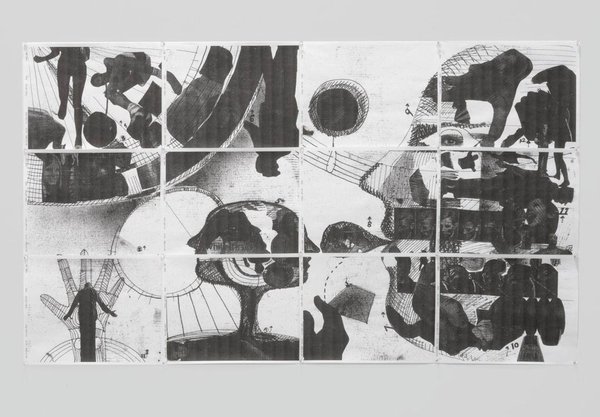Fax
dal 24/2/2010 al 19/6/2010
Segnalato da
Julieta Aranda
John Armleder
Roy Ascott
Tauba Auerbach
Fia Backstrom
Darren Bader
Cecil Balmond
BANK
Colby Bird
Pierre Bismuth
Barbara Bloom
Mel Bochner
Tobias Buche
Ian Burns
Cabinet Magazine
Etienne Chambaud
Cleopatra's
Peter Coffin
Jan De Cock
Collage Center West
Liz Deschenes
Helen Evans
Heiko Hansen
Morgan Fisher
Claire Fontaine
Yona Friedman
Aurelien Froment
Ryan Gander
Liam Gillick
Marisa Gonzalez
Dan Graham
Joseph Grigely
Joao Maria Gusmao
Pedro Paiva
Wade Guyton
Charline von Heyl
Matthew Higgs
Eduardo Kac
Matthew Keegan
Zoe Keramea
Tom Klinkowstein
Germaine Kruip
Glenn Ligon
Ronald L. Mallett
Jackson Mac Low
Corey McCorkle
Josephine Meckseper
Eric Mitchell
Simon Dybbroe Moller
Olivier Mosset
Warren Neidich
Serge Onnen
Hans Ulrich Obrist
Mai-Thu Perret
Michalis Pichler
William Pope. L
Seth Price
Blake Rayne
Tobias Rehberger
Kay Rosen
Amanda Ross-Ho
Pamela Rosenkranz
Arnd Seibert
Matt Sheridan Smith
Alexander Singh
Dexter Sinister
Josh Smith
Skuta Helgason
Anne Tardos
Cheyney Thompson
Christian Tomaszewski
Wolfgang Tillmans
Edward Tufte
Stan VanDerBeek
Olav Westphalen
Christopher Williams
Jack Whitten
Johannes Wohnseifer
Cerith Wyn Evans
Joao Ribas
24/2/2010
Fax
Museo de Arte Carrillo Gil, Mexico City
Fax invites artists, architects, designers, scientists, and filmmakers to think of the fax machine as a drawing tool. Nearly 100 works were sent to the initial showing of FAX at The Drawing Center forming the core of the exhibition. These include new pieces by an intergenerational group of artists as well as seminal examples of early fax art. The show also includes from a leading cognitive scientist, a theoretical physicist working on making time travel possible, and a renowned information designer, among others.

Curated by João Ribas
Co-organized by iCI (Independent Curators International), New York and The Drawing Center, New York
For many years now artists have readily exploited the immediate, graphic, and interactive
character of facsimiles, making the fax an important part of the history of media art, nestled
between the legacy of Fluxus and the nascent practices of new media. How do artists see the
potential of fax transmission today?
Now that the fax machine is a somewhat obsolete technology it can be repositioned as a tool for
producing and conveying information that is intrinsically defined by the mode of transmission.
Furthermore, the reproducible, generative, yet erratic production via the fax machine displaces
traditional notions of “the hand” which are still commonly associated with the medium of
drawing.
FAX invites artists, architects, designers, scientists, and filmmakers to think of the fax machine
as a drawing tool. Nearly 100 works were sent to the initial showing of FAX at The Drawing
Center forming the core of the exhibition. These include new pieces by an intergenerational
group of artists such as Dan Graham, Seth Price, Wade Guyton, Liz Deschenes, Barbara
Bloom, and Tauba Auerbach, as well as seminal examples of early fax art by Stan VanDerBeek,
Marisa Gonsalez,
Sonia Sheridan, Roy
Ascott, Zoe Keramea,
and Eduardo Kac.
The
show also includes
contributions from not
only visual artists, but
from a leading
cognitive scientist, a
theoretical physicist
working on making
time travel possible,
and a renowned
information designer,
among others.
Participants submitted
faxes throughout the
duration of the
presentation, using a
specially-designed cover sheet by Dexter
Sinister. These submissions—arriving in the exhibition space via The Drawing Centerʼs working
fax line—included drawings and texts, as well as errors of transmission and the inevitable junk
faxes. All the transmitted pages were archived or displayed together with the active fax machine.
Visitors were able to view selected fax projects pinned up to the walls and flip through archival
binders to see over 400 pages of works.
For the FAX world tour, which will appear simultaneously at venues all over the world, each
participating institution is encouraged to invite up to twenty additional artists to submit works,
which will then be archived with The Drawing Centerʼs collection to create an evolving document
of all participants. The curators at each institution are free to decide how the works get
displayed on the walls and can rotate the installation throughout their presentations. The result—
an ongoing cumulative project—is an exhibition concerned with ideas of reproduction, obsolescence,
distribution, and mediation.
FAX tour instructions to artists:
Participants are invited to transmit fax-
based work of up to five pages, either
as one work, a composite or “tile‚” or
transmitted over time, via the
museum's working fax line throughout
the duration of the exhibition. A fax
cover sheet will be provided. At the
curator's discretion, some faxes may
be pinned on the wall as well as those
displayed in binders along with the fax
machine.
About the guest curator, João Ribas:
João Ribas is curator at The Drawing Center in New York and a widely published art critic. Among
his recent projects are several surveys, retrospectives, and group exhibitions, including: Frederick
Kiesler: Co-Realities, The Drawing Center, New York, 2008, winner of an AICA Award; New
Economy, Artists Space, 2007; and Expanded Cinema, an online platform for experimental film and
durational work. He is currently adjunct faculty at the School of Visual Arts in New York and
organizing a retrospective of the work of Ree Morton.
Image: Stan VanDerBeek, Panels for Walls of the World Experimental Test, 1969/2009 (installation shot)
Press contact:
Adrian González difusionmacg@gmail.com
Oscar Cigarroa macg.prensa@correo.inba.gob.mx
Tel. 5550 6260 ext. 108 and 109
Opening 25 February 2010
Museo Arte Carrillo Gil
Av. Revolucion, Mexico City
Hours: 10:00-18:00 Tue-Sun



